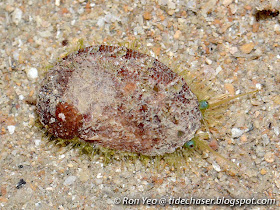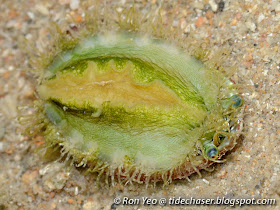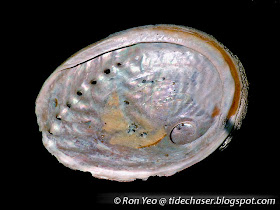Abalones (Haliotis spp., family Haliotidae) are marine snails with ear-shaped shells that are loosely coiled with a row of small openings on the left side for respiration. They are seldom encountered in local waters, and are usually much smaller than the temperate species - the biggest wild abalone that I have seen in Singapore is about 6-7cm long.

Seven species of abalones have been recorded in Singapore: Haliotis asinina, H. clathrata, H. dohrniana, H. varia, H. ovina, H. planata and H. pustulata. The one featured above is Haliotis clathrata, as identified by my ex-colleague from the Raffles Museum of Biodiversity Research, Siong Kiat (thanks a million!). I usually find abalones in Singapore on rocky substrates or coral rubble near coral reefs. They are very hard to identify from photographs and in the field, and most of the time it is only possible to tell the species by cleaning away the flesh and look at the structure of the shells.

Abalones have no operculum. There is a sensory ridge at the margin of their bodies, bearing a series of tentacles. They have a pair of eyes on short stalks.

The head has a short snout. The foot is broad, ovate and very strong - it is usually very hard to remove them when they are stuck to hard substrates.

Abalones feed on macroalgae, and colours of their shells are said to reflect their diet. Abalones are widely considered - not just among the Chinese - to be a delicacy, and there are many farms around the world rearing the bigger species.

Their highly iridescent shells after polishing are used to make into decorative items and jewelries.

Bigger specimens are often covered with encrusting organism, such as the one above which has red coralline algae growing on its shell, and they can blend in very well with the surrounding rocks. To differentiate them from the surrounding rocks, search for the spiral row of holes on the left side of the body whorl.

Wild abalones are regarded to be highly threatened with extinction - not because they are collected for food - but more because they are easily affected by acidification of the ocean (due to increasing levels of carbon dioxide) which erodes their shells.
References

Seven species of abalones have been recorded in Singapore: Haliotis asinina, H. clathrata, H. dohrniana, H. varia, H. ovina, H. planata and H. pustulata. The one featured above is Haliotis clathrata, as identified by my ex-colleague from the Raffles Museum of Biodiversity Research, Siong Kiat (thanks a million!). I usually find abalones in Singapore on rocky substrates or coral rubble near coral reefs. They are very hard to identify from photographs and in the field, and most of the time it is only possible to tell the species by cleaning away the flesh and look at the structure of the shells.

Abalones have no operculum. There is a sensory ridge at the margin of their bodies, bearing a series of tentacles. They have a pair of eyes on short stalks.

The head has a short snout. The foot is broad, ovate and very strong - it is usually very hard to remove them when they are stuck to hard substrates.

Abalones feed on macroalgae, and colours of their shells are said to reflect their diet. Abalones are widely considered - not just among the Chinese - to be a delicacy, and there are many farms around the world rearing the bigger species.

Their highly iridescent shells after polishing are used to make into decorative items and jewelries.

Bigger specimens are often covered with encrusting organism, such as the one above which has red coralline algae growing on its shell, and they can blend in very well with the surrounding rocks. To differentiate them from the surrounding rocks, search for the spiral row of holes on the left side of the body whorl.

Wild abalones are regarded to be highly threatened with extinction - not because they are collected for food - but more because they are easily affected by acidification of the ocean (due to increasing levels of carbon dioxide) which erodes their shells.
References
- Byrne, M., Ho, M., Wong, E., Soars, N. A., Selvakumaraswamy, P., Shepard-Brennand, H., Dworjanin, S. A. & Davis, A. R. 2010. Unshelled abalone and corrupted urchins: development of marine calcifiers in a changing ocean. Proceedings of the Royal Society of London, Series B: Biological Sciences, 278(1716): 2376–2383.
- Carpenter, K. E. & V. H. Niem (eds), 1998-2001. FAO species identification guide for fishery purposes. The living marine resources of the Western Central Pacific. Volumes 1 to 6. FAO, Rome. pp. 1-4218.
- Gladys Archerd Shell Collection at Washington State University Tri-Cities Natural History Museum. 2008. Retrieved September 26, 2012, from http://shells.tricity.wsu.edu/ArcherdShellCollection/ShellCollection.html.
- Oliver, A. P. H. 2012. Philip's guide to seashells of the world. Philip's, London. 320 pp.
- Tan, K. S. & L. M. Chou, 2000. A guide to common seashells of Singapore. Singapore Science Centre, Singapore. 168 pp.
- Tan, S. K. & H. P. M. Woo, 2010. A preliminary checklist of the molluscs of Singapore. Raffles Museum of Biodiversity Research, National University of Singapore, Singapore. 78 pp. Uploaded 02 June 2010.

No comments:
Post a Comment